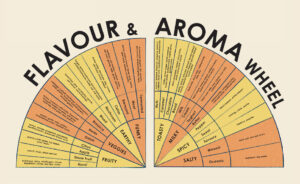 Extracted from The Best Things In life Are Cheese by Ellie and Sam Studd, Macmillan Publishers, RRP $49.99
Extracted from The Best Things In life Are Cheese by Ellie and Sam Studd, Macmillan Publishers, RRP $49.99
FLAVOUR = TASTE + MOUTHFEEL + AROMA + MIND
Flavour is fascinating and complex. So what happens when you first see and then eat a piece of cheese? Put on your lab coat, it’s time to strap in for some science.
We experience cheese through our five senses: sight, smell, taste, touch and sound. Wavelengths of light are converted to colours when we see the cheese, while molecules in the cheese are detected by receptors on our tongue and 8000 tastebuds, which perceive the five basic tastes of salty, sour, bitter, sweet and umami/savouriness. There is now evidence that the brain can actually detect fat as a flavour, but let’s park that for now. Fascinatingly, it is only in conjunction with the nose that we are able to discern specific aroma compounds, such as mushroom or nuts. In fact, aromas are responsible for 80 per cent of flavour perception. Molecules in the air are detected by the receptors in the nose and converted into aroma compounds, such as fruity, earthy and floral.
When we chew on cheese, a second layer of smell is triggered, as aromas and volatile compounds pass through our retronasal region (the back of the throat that connects the nose and mouth). Interestingly, smell is connected directly to our limbic system, the part of the brain where memories and emotions are stored. It helps us to navigate what we can eat, as well as steer us away from putrid and off foods as a form of survival. When we smell the cheese, our brain basically flips through a Rolodex of memories and aromas (up to 10,000) and compares it to an experience we have had before.
Touch is also processed by the brain through the temperature and texture of the cheese in our mouth, then converted to signals between neurons in the brain, as well as sound. This information is then woven together and integrated into our brain, which recognises and computes it as a conscious experience: ‘I just ate cheese, and I liked it’. This is the intersect of flavour.
We also taste with our heart and spirit. And no, we haven’t been consulting crystals for this one; research acknowledges neurological interpretations of food as a conscious and unconscious experience that can add bias to the way we perceive flavour and our enjoyment of food. It includes how we prefer our mother’s mascarpone pie over that of a Michelin-starred chef, and how there are long and passionate histories of traditional cuisines across the globe.
Cheese is also said to bring up emotional experiences from our primordial programming and mammalian diet. Neuroscientist Dr Thomas Morell, in Max McCalman’s Mastering Cheese, theorises that because cheese is energy and nutritionally dense, there could be a subconscious embedding from our ancestors to experience it as more pleasurable for survival. A recent psychology review on food rewards reveals that the gut–brain pathway senses nutritive qualities in food and activates the brain reward circuit. Another explanation for our attraction to cheese is due to it having high concentrations of tyrosine. This amino acid is responsible for regulating stress and mood, and needs to be supplemented in our diets as we have naturally low levels. When we eat cheese, our body breaks down the tyrosine further into casomorphin, a feel-good chemical that activates dopamine as well as the areas of the brain that respond to morphine and heroin. This could be your cheeky excuse to explain why your feet remain planted next to the cheese board at a party.











Join the Discussion
Type out your comment here:
You must be logged in to post a comment.